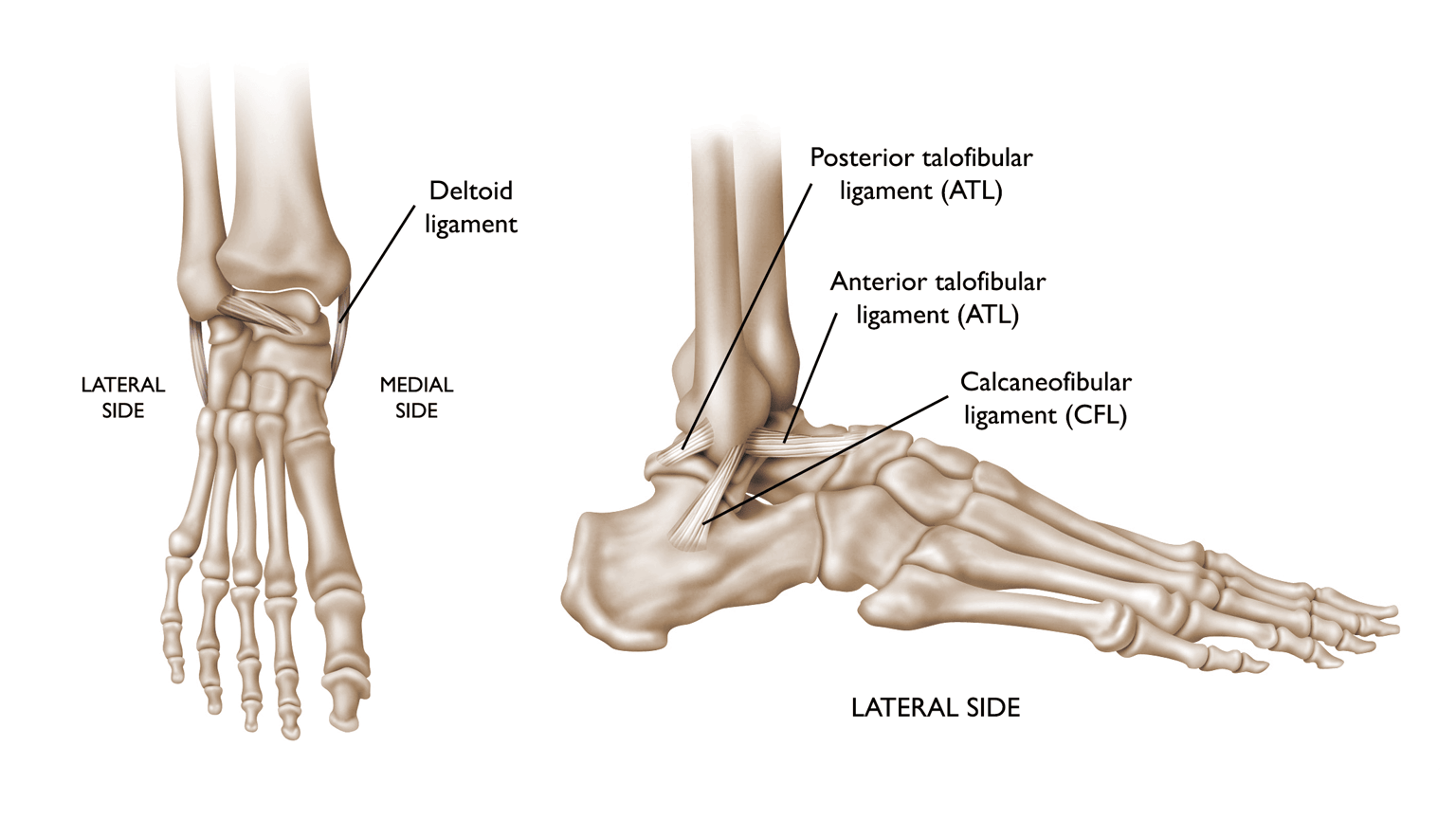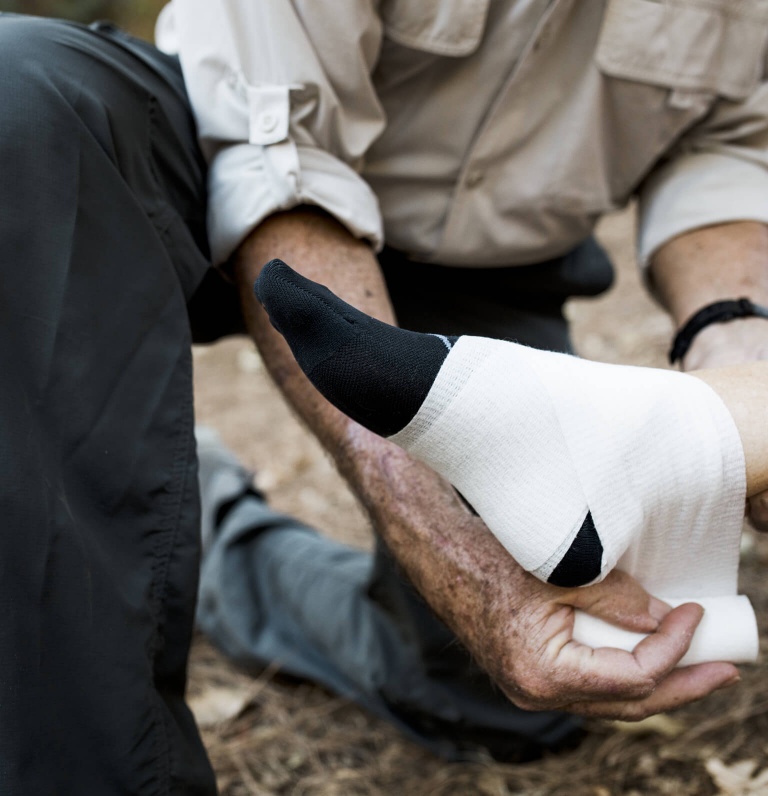Ankle Ligament Injuries
According to a report published by the University of Edinburgh (Westwick-Stevenson et al., 2021), ankle sprains are one of the most common musculoskeletal injuries affecting those participating in sports and exercise. It’s estimated that significant ankle ligament injuries, or SALI, account for up to 5% of all accident and emergency hospital visits in the UK and these injuries are associated with the future risk of chronic ankle instability, osteoarthritis of the ankle, and other degenerative joint changes. It is thought that up to 70% of all ankle osteoarthritis cases are associated with a previous ankle injury, although it must be acknowledged that there is limited research to support this theory.
As a fitness instructor, personal trainer or sports massage therapist working with clients affected by ankle injuries, it’s necessary to have an understanding of the complex anatomy of this joint, and the factors that cause different types of injuries. This is what we will explore in this blog.
Anatomy of the ankle
The ankle joint is created by the articulation of the tibia and fibula with the talus bone to create a synovial hinge joint. Like all hinge joints, it’s able to flex and extend, or in the case of the ankle, that is dorsiflexion or plantarflexion.
The ankle joint is further reinforced and strengthened by bands of fibrous tissue known as ligaments. These ligaments, which are largely comprised of type 1 collagen fibres, ensure that the ankle remains stable during gait, limiting lateral movements while ensuring that the joint can move freely between dorsiflexion and plantar flexion. The ankle joint is capable of a limited range of inversion, eversion, and rotational movements, and it’s the combined result of the shape of the bones and the ankle ligaments which limit these movements. When these ligaments become damaged or overstretched, as is the case with chronic ankle instability, then the future risk of injury, compensatory movements, and pain is dramatically increased.
Ligaments of the ankle Joint

The main ligaments of the ankle joint are:
- Medial Ligament – also known as the deltoid ligament, the medial ligaments consist of four bands that collectively stabilise the inside surface of the ankle area. These ligaments are triangular in shape and have two layers, superficial and deep. Their main function is to prevent the ankle from over-eversion or overpronating.
- Lateral Ligament – located on the lateral surface (outer aspect) of the ankle, this ligament is comprised of three separate bands, namely, the anterior (front) and posterior (back) talofibular, and calcaneofibular (middle). It works to stop over-supination of the foot or ‘rolling the ankle’.
- Syndesmotic Ligaments – these are ligaments that bind the distal (furthest away from the body’s centre) tibia and fibula at the distal tibiofibular syndesmosis. Injury of these is what we refer to as a ‘high’ ankle sprain. The ligaments most likely to get injured in this area are the anterior inferior tibiofibular ligament, posterior inferior tibiofibular ligament, and the interosseous ligament.
The primary functions of the ankle ligaments are to provide reinforcement 3-dimensional stability to the joint structures and prevent excessive movement.
How is the ankle injured?
The ankle joint supports the weight of the whole body and it plays a part in preventing the arches of the foot from collapsing during gait (walking, running, etc).
Ankle ligament injuries occur when the foot is turned, putting a large downward and rotational force through the bones and ligaments. This may cause the ligaments to get stretched or torn. This can happen during competitive sports that involve frequent changes of direction such as football, basketball, and tennis. It can also happen while running or walking on an uneven surface, such as trail running or hiking, or when slipping off a curb.
Ankle injuries can also become complicated if accompanied by a fracture or tendon injury. The peroneal tendons (arising from peroneus longus and peroneus brevis) frequently get injured when the lateral ankle ligaments are injured.

Types of ankle ligament injury
There are three main types of ankle ligament injury:
- Inversion ankle sprains – the anterior talofibular ligament (ATFL), which is located deep within the joint capsule, has a high incidence of injury in sports participants and exercisers alike. Interestingly, most ankle ligament sprains are of ATFL origin. An ATFL sprain is also sometimes accompanied by a calcaneofibular ligament (CFL) injury. Sometimes, a piece of bone might disassociate from the distal fibula along with the ligament (avulsion injury), which would typically be discovered on imaging.
- High ankle sprain – this ligament injury occurs to the syndesmotic ligaments located between the tibia and fibula and is usually the result of rotational forces. Due to the location of the affected tissues relative to the ankle joint, the injury mechanism is informally known as a ‘high ankle sprain’. The incidence of these injuries tends to be quite a bit lower than others, affecting around 20% of total ankle ligament injury cases. While less prevalent, these injuries tend to be more serious and take a longer time to heal. High ankle sprain injuries occur when the foot is firmly planted on a flat surface and the lower leg or foot twists, causing the two leg bones to separate and move in different directions.
- Eversion ankle sprain – these injuries occur when the foot moves laterally (outwards) beyond the control of the ligaments and muscles. Due to the fact that it has two layers, the deltoid ligament (located medially) is stronger than the lateral ligament and is therefore less commonly injured. It is however more frequently damaged as a result of serious trauma to the ankle, such as a high-impact trauma causing the foot to move laterally under load and speed.
Grades of ankle ligament injury?
Doctors usually classify ankle ligament injuries into the following three grades:
- Grade 1 – a mild tear, just over-stretching the ligament, causing minimal pain and swelling. The range of motion is usually not affected and the ankle is able to support your body weight.
- Grade 2 – a moderate and painful injury, causing partial tearing and swelling. There will usually be difficulty in weight-bearing, and mobility will be affected to a certain degree.
- Grade 3 – A significant injury involving the complete rupture of the ligaments. There will be a significant amount of pain, bruising, and swelling, and movement is painful in most directions.
Diagnosis
An ankle ligament injury is diagnosed after a careful history and examination. The doctor will check the range of motion at the joint and assess the degree of pain and swelling. In cases of moderate to severe injury, imaging is also usually performed.

The following imaging studies may be performed to diagnose an injury to the ankle ligaments:
- X-rays – for ruling out associated fractures of the ankle bones
- Ultrasound – used to determine if there is a rupture of the ankle ligament.
- Magnetic Resonance Imaging (MRI) – used in diagnostic uncertainty if X-ray or ultrasound are unable to determine the full extent of the injury. MRI is often performed where a complete ligament tear needs to be ruled out
How is an ankle ligament injury treated?
Grade 1 – Ankle ligament injuries are treated according to their degree. Grade 1 injuries are usually managed conservatively, by following the PRICE protocol. This means that the limb must be protected, icing the affected area, ankle compression for managing swelling, and elevating the leg where possible (PRICE principle).
Grade 2 – Over-the-counter painkillers like ibuprofen or naproxen may be prescribed for a Grade 2 injury. Along with ankle immobilisation to allow healing, sports massage and other mobilisation techniques may be used, including:
- Effleurage – flat strokes to increase blood circulation
- Petrissage and tapotement – kneading movements to increase ankle flexibility
- Soft tissue mobilisation and manipulation – deep pressure and manual stretching technique, which treats joint dysfunction and allows the fluid causing the swelling to drain. Gliding movements at the tibiofibular and talocrural joints are given, treating the ligaments and improving mobility and pain.
Grade 3 – This is the most severe ligament injury to the ankle and usually requires surgery. An arthroscopy will be performed under general anaesthetic to determine the extent of the injury and the most appropriate treatment. Ligaments that are torn, ruptured or overstretched will be shortened, stitched or re-attached as required.
Following surgery, a full rehabilitation programme will be required from a suitably qualified physiotherapist or sports rehabilitation specialist. Proprioceptive training, unstable ankle stability exercises, and resistance band exercises are usually performed to strengthen the muscles around the ankle and to improve ligamentous tone. A thorough rehabilitation protocol that isn’t rushed will decrease the risk of injury recurrence.
Balance and proprioception
Following an ankle injury, it is necessary to restabilise the joint for balance. Proprioception is the ability of the body to sense how specific joints and structures are positioned in time and space and when this mechanism is compromised, the future risk of injury is considerably increased.
Some proprioception exercises include:
Tandem exercise – also called the heel-toe exercise, one foot is placed in front of the other, with the heel touching the toes of the one behind.

Stork balance exercise – balancing on the injured foot, sometimes on an unstable surface, with eyes closed.

One leg squat – while standing, the uninjured foot is raised, while slowly lowering into a squat.

Step up/step down – on a platform that is at least six to eight inches higher than the ground.

Half squats – done on an uneven surface, like a wobble board.

Possible Complications
If ankle ligament injuries are left untreated, or are of a more complex nature, possibly involving fractures and/or tendon ruptures, then they are far more likely to result in more significant complications. In this situation, chronic pain may develop, hindering routine daily activities, especially those involving gait (e.g. walking). Arthritic changes can also develop with chronic ankle injuries, causing joint degeneration and a downward spiral of more pain and dysfunction. This is why it is important to seek professional help as early as possible.
Conclusion
Ligament injuries of the ankle can cause significant distress to patients and are prone to becoming long-term chronic issues if not appropriately treated. However, with proper diagnosis and treatment, most patients are able to return to a high level of sport and physical activity quickly.
References
Westwick-Stevenson, T., Wyatt, L.A., Palmer, D. et al. Incidence and risk factors for poor ankle functional recovery, and the development and progression of posttraumatic ankle osteoarthritis after significant ankle ligament injury (SALI): the SALI cohort study protocol. BMC Musculoskelet Disord 22, 362 (2021). https://doi.org/10.1186/s12891-021-04230-8


